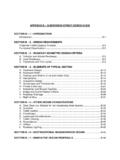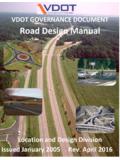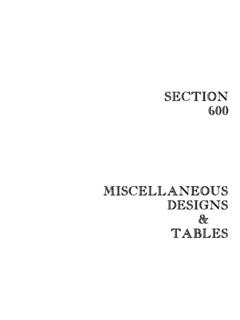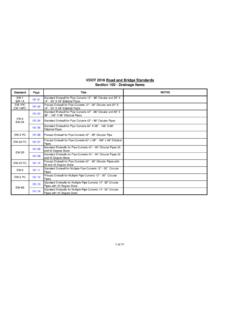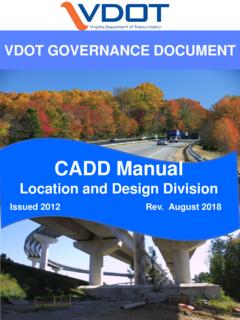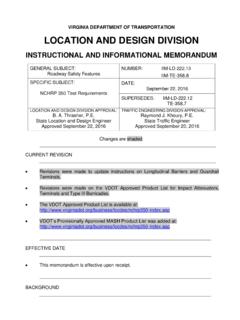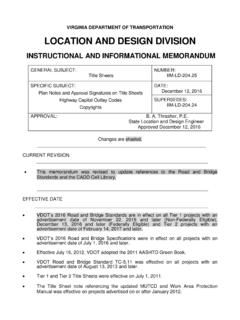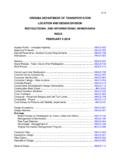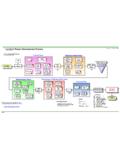Transcription of CHAPTER 2E - extranet.vdot.state.va.us
1 CHAPTER 2E - PHASE III, FIELD INSPECTION section 2E 1 - SOIL SURVEY AND PAVEMENT design Soil Survey and Pavement design Received .. 2E-1 Resolution of Borrow / Surplus and Unsuitable Material .. 2E-1 section 2E 2 - DETAILED DRAINAGE design .. 2E-7 section 2E - 3 - DETAILED PLAN design Curb and Gutter .. 2E-8 Curb .. 2E-8 Medians .. 2E-8 Staking For Concrete Items .. 2E-11 Fence .. 2E-15 Retaining Walls .. 2E-17 Retaining Wall Excavation .. 2E-18 Retaining Structures .. 2E-21 Reinforced Soil Slope (RSS) Standard .. 2E-21 Sound Barrier Wall design Procedures .. 2E-24 Steps and Handrails .. 2E-26 Sidewalk .. 2E-27 Sign Islands .. 2E-27 Railways: Adjacent Highway design Considerations .. 2E-27 Bicycle Facilities.
2 2E-29 Greenways .. 2E-29 Underdrains .. 2E-29 Demolition of Existing Pavement and Obscuring Roadway .. 2E-30 Tree Walls and Tree Wells .. 2E-35 Labeling Incidental Items .. 2E-35 Pedestrian Ramps .. 2E-35 Curb and Curb and Gutter .. 2E-35 Grading Contours .. 2E-36 Construction of Cattle Passes .. 2E-36 Historical Marker Relocation .. 2E-37 section 2E - 4 - SHOWING BRIDGE LIMITS ON PLANS Determining Approximate Length of Bridge .. 2E-38 Determining Approximate Width of Bridge .. 2E-38 Depicting On Plans .. 2E-38 section 2 E - 5 - PROPOSED RIGHT OF WAY AND LIMITED ACCESS Determining Proposed Right of Way Encompassing Slope Limits .. 2E-39 Determining Proposed Right of Way With Slope Easements .. 2E-40 Determining Slope Easements.
3 2E-40 Determining Permanent Easements .. 2E-41 Temporary Construction Easements .. 2E-42 Utility Easements .. 2E-44 Limited Access Establishment and Change Guidelines .. 2E-47 Limited Access Lines .. 2E-51 Limited Access Fencing .. 2E-51 Depicting Limited Access Right of Way .. 2E-52 Determining Surplus Right of Way .. 2E-55 Right of Way Description Furnished To Environmental Division .. 2E-56 Plan Revisions .. 2E-57 section 2E - 6 - PREPARATION OF SUPPLEMENTAL SHEETS Title Sheet .. 2E-58 Identification .. 2E-58 Layout .. 2E-59 Description .. 2E-60 Project Length Tabulation Block .. 2E-60 Functional Classification - Traffic Data .. 2E-64 Notes .. 2E-64 Project section Numbers .. 2E-64 Index Of Sheets.
4 2E-66 Project Location 2E-69 Right Of Way Data Sheet .. 2E-69 Typical section Sheet(S) .. 2E-71 Hydrologic Data Sheet .. 2E-72 design Features Note .. 2E-74 Additional Notes .. 2E-74 section 2E-7- CONSTRUCTION COST ESTIMATE Estimating Quantities - Preparation of Estimate .. 2E-75 section 2E-8- CONSTRUCTABILITY QUALITY REVIEW Constructability Quality Review .. 2E-76 section 2E 9 - DISTRIBUTION OF FIELD INSPECTION PLANS Plan Assembly .. 2E-77 section 2E 10 - FIELD INSPECTION Holding Field Inspection .. 2E-79 Safety Items and Sequence of Construction .. 2E-79 Request For Special design Plans .. 2E-80 Request For Sound Barrier Wall 2E-81 Bridges .. 2E-81 section 2E - 11 - REQUEST FOR ADDITIONAL SURVEY DATA Procedure For Request.
5 2E-82 section 2E 12- DISTRIBUTION OF PRINTS Procedure .. 2E-83 section 2E-13 UTILITY FIELD INSPECTION .. 2E-84 LIST OF FIGURES Figure 2E-1 Plan Development/Resolution of Borrow/Surplus & Unsuitable Material .. 2E-4 Figure 2E-2 Typical Method of Placing Unsuitable Material .. 2E-5 Figure 2E-3 Incorrect Method of Placing Unsuitable Material .. 2E-5 Figure 2E-4 Typical Method of Showing Placement of Unsuitable Material On Plans .. 2E-6 Figure 2E-5 Typical Straight-Line Taper Lane .. 2E-12 Figure 2E-6 Method of Showing Required Information On Roadway Plan Sheets For Radial Offsets Turn Lanes Bullet Noses .. 2E-13 Figure 2E-7 Sample Tabulation of Data .. 2E-14 Figure 2E-8 Profile For Proposed Retaining Wall.
6 2E-26 Figure 2E-9 Depicting Temporary Construction Easement Around Entrances* .. 2E-43 Figure 2E-10 Depicting Limited Access Right-of-Way .. 2E-53 Figure 2E-11 Depicting Limited Access Right-of-Way .. 2E-54 Figure 2E-12 Construction Type Code For Highway Improvements Line Item Codes .. 2E-65 Figure 2E-13 Sample Hydrologic Data Sheet (No Plan Project) .. 2E-73 2E-1 CHAPTER 2E - PHASE III, FIELD INSPECTION section 2E 1 - SOIL SURVEY AND PAVEMENT design SOIL SURVEY AND PAVEMENT design RECEIVED Soil survey and pavement design recommendations are not always received prior to field inspection. Should they be received just prior to the field inspection, every effort should be made to have the recommendations included in plans prior to printing.
7 In some cases, the field inspection will be held based on the preliminary pavement design without the benefit of the soil survey. (See section 2E-6-TYPICAL section SHEET) RESOLUTION OF BORROW / SURPLUS AND UNSUITABLE MATERIAL vdot 's Road and Bridge Specifications requires that the contractor deposit unsuitable and surplus material off the project if the plans do not require that the material be placed within the right-of-way. The procedural flow chart (See Figure 2E-1) is self-explanatory in the development of plans to resolve the disposition of materials on either a borrow or surplus project in connection with disposal areas and borrow pits. The non-environmentally sensitive fill areas within the limits of a project should be reviewed for possible locations to dispose of unsuitable material.
8 Do not place disposable material in areas where retaining walls or sound walls will be used. Check all proposed drainage items pertinent to this procedure. In some instances, the Materials Division will recommend that disposable material be placed in the bottom of fills; however, the available areas may or may not satisfy the volume of material to be disposed. The designer must therefore look to other methods of placing this material along with the placement of surplus root mat material that may be disposed of by using it to cover fill slopes. Placement of unsuitable material in fills is limited to an elevation 6 feet below the top of the proposed subgrade at the side slope.
9 This will prevent entrapment of moisture in the embankment below the pavement structure (See Figure 2E-2). Unsuitable material is defined as highly plastic clay soil (PI 35). Wet material (moisture content > 30 percent above optimum moisture content), muck, peat, and other deleterious material. Organic material (stumps, tree trunks, limbs, roots, leaves, grass cuttings) shall not be disposed of on slopes. A plan for disposal of all unsuitable material shall be submitted by the Contractor to the Engineer at least 7 days prior to disposal for review. 2E-2 Inorganic material such as brick, cinder block, broken concrete, (without exposed reinforcing steel) asphaltic concrete, rock or other such material may be disposed of in fills.
10 Consideration should be given to flattening slopes using borrow on top of unsuitable material instead of installing guardrail (Exception: When major slopes of 3:1 and flatter will provide an acceptable condition for a vehicle leaving the roadway. Provide recoverable 6:1 slope when possible (See Appendix A for guidelines). Gore areas of ramps and median areas of divided facilities (unless they are used for stormwater management) are prime areas for placing disposable material. (See Figures 2E-2 and 2E-4) It is also likely that in some cases, such as the placement of unsuitable material in the bottom of fills, that borrow can be reduced, thereby reducing the cost of a project.)
